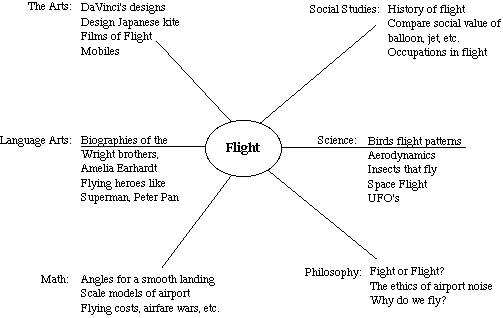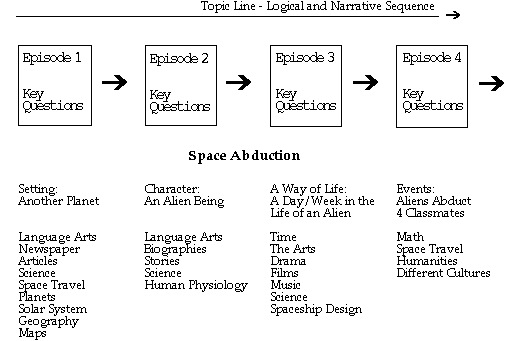The child must be viewed as active at all levels -- as purposer, an investigator, a constructor of his own knowledge." -Evelyn Weber
- nBased on a theory that learning is complex, and multi-layered
- Learning is guided by one’s prior knowledge and experience
- Therefore, learners construct their own meaning through action and experience.
- nIt creates a context for learning through active involvement of the child.
- nProvides tasks that arise from the context, which the child sees as significant and meaningful within it.
- nGives opportunities to develop understanding and skills with the support of the context.
Process: Teacher guided
n
1. The topic line is a logical progression and a narrative sequence.
1. The topic line is a logical progression and a narrative sequence.
n2. The topic writer sets out key questions within each episode that all students must address.
n3. Each key question relates to the particular episode of the narrative.
n4. Each
episode has infinite potential in terms of possible development and
investigation. The extent is determined by student motivation.
n5. Each child will reach different levels within each key question and will return to the Storyline for the next question.
Integrated Curriculum:
Integrated Curriculum:

diagram from Glasgow University, Scotland
Storyline Method:

Diagram from Glasgow University, Scotland
Planning Sample Worksheet:
|
Yaks in My Yard-At Home in the Himalayas--Storyline |
|||||
|
Story Episodes |
Key Questions |
Possible Activities |
Class Organization |
Resources |
Goals/Objectives |
| Lesson 1 Introducing Himalayas-Physical Geography | How can we make a model to show this environment? | introduce context terrain and information about physical geography with slides /pictures/guided imagery.See lesson 1 | whole class slides/guided imagery | internet, "close your eyes, hear the waterfall", music of environmental sounds, slides of Himalayas | #4Characteristics of place #8Characteristics and spatial distribution of ecosystems on Earth's surface |
| Lesson 2 Breathe life into the Storyline | Who lives in villages? | make people-write biographies, read or write stories | individual | multicultural paper, lesson 2, | #9 human characteristics |
| Lesson 3 Design and build a house | What are some problems a house in this environment might face?What materials would they use to build a home?Where would they get those materials? | gather supplies, design and build a house, take or draw pictures for topic books | small groups | students bring in found materials, stones, clay, sand,sticks.two foot square board for support, glue, string, 1/2 "gravel, paper mache making equipment (blender, dish bins, screen, newspaper) | # 15 How physical systems affect human systems |
| Lesson 3 continued Family and Friends | What do you need to live in a house with no electricity or running water? | make objects for house | groups | Material World, scrap paper, glue, tape | # 14 How human actions modify the physical environment # 11 patterns and networks of economic interdependence on Earth's surface |
| Lesson 4 It takes a village | What work would Sherpa's do? Would they go to school? Where? | create feize with homes in foreground on tables, make an animal | individual with group | map, criteria for placement see lesson | |
| Lesson 5 Teacher arranged Incident Split land, share amongst children OR Natural disaster | What do you do when you have this decision to make? | Plot EPISODE Possible Scenario I or II | groups | Role Playing their solutions to this problem given the criteria: | # 12 forces of cooperation/conflict among people influence division and control of earth's surface |
| Lesson 6 Ceremony or Celebration Closing | What kind of ceremonies do people have in their lives? | Celebrate ceremony with other class or parents, take video ceremonies | village | Books, posters, video, slides, Nepali stories including ceremonies, documentary and fiction movies | # 10 characteristics, distribution, complexities of Earth's mosaics#17 & 18 Uses of geography understanding relationships between people, places, environment over time |